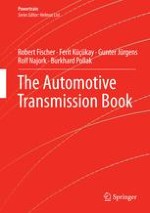2015 | OriginalPaper | Chapter
2. Shift Dynamics and Shift Comfort
Authors : Robert Fischer, Ferit Küçükay, Gunter Jürgens, Rolf Najork, Burkhard Pollak
Published in: The Automotive Transmission Book
Publisher: Springer International Publishing
Activate our intelligent search to find suitable subject content or patents.
Select sections of text to find matching patents with Artificial Intelligence. powered by
Select sections of text to find additional relevant content using AI-assisted search. powered by
